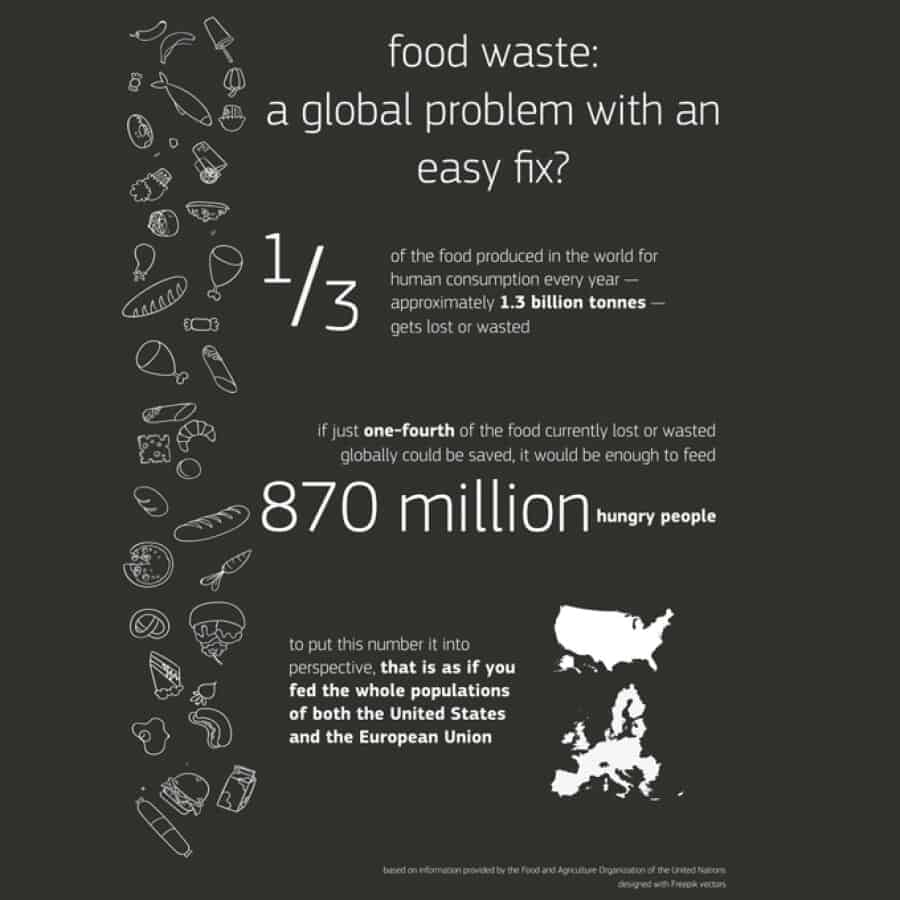Around 1.3 billion tonnes of food get lost or wasted annually around the globe. In a world where one in nine people suffers from chronic undernourishment, these numbers should not only shock but should cause an immediate reaction. Read on to discover some of the inspiring initiatives that aim to tackle the problem of food waste.
The numbers in this infographics speak for themselves. The first step in solving a problem is to recognize that there is one. The second step is to realize that the problem is not impossible to solve. As Dana Gunders of the Natural Resources Defense Council has stated in an interview with Vox, “Of all the challenging problems out there, reducing the amount of food we are wasting is one of the easiest”. The third step is finding and implementing solutions.
The amount of food we waste should shock and lead to immediate action. Food waste occurs at every level of the value chain, and solutions have to occur at all of these levels, too. Thankfully, from giving the food away to the needy to social campaigns to creating businesses based on food that would otherwise to go waste, there are many examples that should and must be followed.
Simple solutions
You have probably heard about the Massachusetts Institute of Technology in the context of its famous alumni such as Kofi Annan, the former Secretary-General of the United Nations, and world-changing inventions like GPS, the World Wide Web, or the fax machine. Not so well-known, but definitely brilliant in terms of combating food waste, is an MIT invention that dates back to the 1990s: the FoodCam. In MIT’s Media Lab, a camera that beams a photo of leftovers to the entire lab has been installed. Whenever there are leftovers from, say, a scientific conference, the organizers can bring the leftovers to the kitchen, leave them under the FoodCam, and simply press the button which activates the camera and sends an alert through Twitter, an e-mail list, and Slack to everyone in the building. Considering that an invention this smart came into being in the 1990s, long before modern social media, we must conclude that we have the tools to move from a FoodCam that reaches the people in one building to larger-scale solutions.
“Of all the challenging problems out there, reducing the amount of food we are wasting is one of the easiest”, says Dana Gunders of the Natural Resources Defense Council in the interview with Vox.
Think globally, act locally
Hunger is one of the most pressing world issues. However, global problems such as food waste can be tackled only when addressed locally. Copia is a San Francisco-based real-time excess food management solution for organizations of all sizes. The founders recognized the problems that arose from the lack of possibilities to deliver food to those who needed it and created a solution which is referred to as the “Uber of food recovery and distribution”. For example, if a company has a surplus of food from a corporate event or there are leftovers from a big party, one just needs to prepare and package the food and schedule a pickup through the app. Copia‘s certified food handlers will then collect the food and deliver it to the needy.
Waste is not profiting anyone – fighting waste does
Generally speaking, waste does not bring profit anyone. Also taking into consideration purely economic considerations – food which is wasted does not generate profit for the sellers. In Italy, the Last Minute Sotto Casa app solves the problem of food waste at the level of distribution and is a perfect example of collaborative economics at work as every party involved wins. The app – with a name which translates to “last minute next door” – sends alerts to registered users whenever shop owners have perishables to sell at discounted prices.
Joint efforts
In 2010, the town council of Brno, a city in Czechia, joined efforts with local businessmen to combat food waste in restaurants. Unsold meals prepared as “meals of the day” are given to homeless people. In just one year, thanks to this initiative, approximately 14 thousand servings of quality food were distributed to the needy. The cost of the whole project has been minimal as it relies on the central office for social services in the city, which has its own cars and drivers. The organizers of the initiative keep on involving new Brno companies and have even managed to attract the attention of other cities in the country. That is definitely a great example to follow!
Recovering every bit
Even though some by-products developed during food processing might seem to be unrecoverable as they are traditionally considered waste, researchers and innovative companies keep on finding ways to use them to their fullest. For example, in Denmark, the hospitality and restaurant sector owners have formed a partnership to develop an Omega 3-rich fish chip product from otherwise inedible fish waste. According to recent studies, given that over 50% of fish is discarded as inedible waste, this is an excellent use for a product that would otherwise be wasted.
Be the change you wish to see
Need some tips on how to be a sustainable consumer of food? Check out another text we have prepared for you – Food Waste: Solutions Are Easier than You Think.
The Story of Ifreet Taheea, a Food Blogger Who Raised $10,000 for Bangladesh Families is published here.
Support us!
All your donations will be used to pay the magazine’s journalists and to support the ongoing costs of maintaining the site.
Share this post
Interested in co-operating with us?
We are open to co-operation from writers and businesses alike. You can reach us on our email at [email protected]/[email protected] and we will get back to you as quick as we can.









